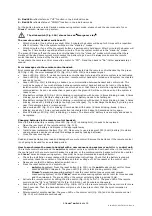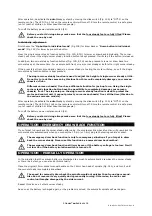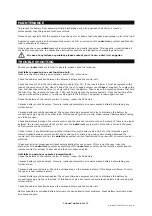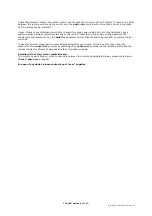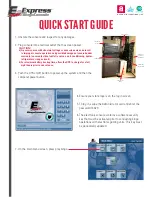
EN
DURO
®
autoSteady 34
Ref: AS101-UM-TKI-0114-Rev. A
Do not exceed the total safe working load of the laden weight of the original corner steady.
Sensitive objects such as cameras, DVD-Players etc. must not be kept in the storage box near the
control unit or the motor cable. They can be damaged by the electromagnetic fields.
Do not make any modifications to the autoSteady system (mechanical or electronic). This can be very
dangerous! No warranty claim will be accepted and we cannot warrant the function of the autoSteady
system if any modifications are made. We will not be liable for any damage whatsoever caused as a
result of incorrect installation, operation or modification.
OPERATION - REMOTE CONTROL HANDSET
The supplied double mode remote control handset (6) can be used for the EN
DURO
®
autoSteady system and
most EN
DURO
®
caravan manoeuvring systems (models >2013). The control mode can be selected by moving
the slide switch (Fig. 10O) to “Caravan manoeuvring system mode” or “autoSteady system mode”.
The remote control handset (6) is powered by one PP3 9Volt battery, and is activated by moving the slide
switch to “On”-I (Fig. 10A). Once activated the green LED (Fig. 10H) will illuminate and the controls can now be
used.
Fig. 10 (autoSteady mode):
A – Main power slide switch: “Off”=O and “On”=I.
B – Up button in individual mode: Select the draw-back function for single corner steady function buttons.
After this button is pressed, the red LED above this button will light up. Then you can push the single corner
steady function buttons for draw back. Without this selection the single corner steady function buttons are not
workable. If there is not any operation within 30 seconds, the LED will turn off and invalidate the “UP” choice.
C – Down button in individual mode: Select the lower function for single corner steady function buttons.
After pressing this button, the red LED below this button will light up. Then you can push the single corner
steady function buttons for lower. Without this selection the single corner steady function buttons are not
workable. If there is not any operation within 30 seconds, the LED will turn off and invalidate “Down” choice.
D – Right-front single corner steady function button: Adjust Right-front corner steady (see Fig. 8) draw
back or lower by keep pushing the button. Choose the “UP” or “DOWN” button first.
E – Left-front single corner steady function button: Adjust Left-front corner steady (see Fig. 8) draw back
or lower by pressing the button. Choose the “UP” or “DOWN” button first.
F – Right-back single corner steady function button: Adjust Right-back corner steady (see Fig. 8) draw
back or lower by keep pushing the button. Choose the “UP” or “DOWN” button first.
G – Left-back single corner steady function button: Adjust Left-back corner steady (see Fig. 8) draw back
or lower by pressing the button. Choose the “UP” or “DOWN” button first.
H – Green power LED: Power LED continuously lights up when the system is activated (by moving slide switch
of the remote control to “On”-I). If the remote control is far away from the control unit, beyond the availably
distance, this LED will start blinking.
I - Two handed buttons for automatic up function: The “AUTO UP” button must be pressed for more than
3 seconds. The blue “automatic function” LED will blink and the buzzer also gives a beep per second. Then the
automatic draw back process begins. If press it for less than 3 seconds, nothing happens (this is a setup to
avoid misoperation). After three seconds the automatic lower or draw back begins, and the blue “automatic
function” LED will illuminate constantly. Now you can release the button, and the draw back process will auto
process. After the automatic draw back process is completed, the buzzer will give a beep.
J - Two handed buttons for automatic down function: The “AUTO DOWN” button must be pressed for
more than 3 seconds. The “automatic function” LED will blink and the buzzer also gives a beep per second.
Then the automatic lower process begins. If press it for less than 3 seconds, nothing happens (this is a setup to
avoid misoperation). After three seconds the automatic lower process begins, and the “automatic function” LED
will illuminate constantly. Now you can release the button, and the lower process will auto process. After the
automatic lower process is completed, the buzzer will give a beep.
Before the corner steadies move downwards, there maybe a several second delay without any operation or the
corner steady draw back a short time (about 3 seconds). This is normal.
K - Blue “automatic function” LED: Reflects status of the “AUTO UP” and “AUTO DOWN” system.
L - Red overload LED: Amp overload protection is activated. Wait about 60 seconds and try again.
M - Blue 9V battery LED: The internal 9V battery of handset is near empty and needs to be replaced.
N - Blue battery voltage LED: The caravan battery voltage is too low or too high.
O - Control mode slide switch: The control mode can be selected by moving the slide switch (Fig. 10O) to
“P” or “Q”. If moving the slide switch (Fig. 10O) to “P” (indication becomes red), the combined remote handset
is working in the caravan manoeuvring system mode. If moving the slide switch (Fig. 10O) to “Q” (indication
becomes red), the combined remote handset is working in the autoSteady mode.
P - Caravan manoeuvring system mode indicator: Reflects status of remote handset. When the remote
handset is set into the caravan manoeuvring system modes, an EN
DURO
®
caravan manoeuvring system can be
controlled via this remote handset. Please see functions of the buttons in the caravan manoeuvring system user
manual. NOTE: in this mode the autoSteady system will not work!
Q - autoSteady control mode indicator: Reflects status of remote handset. When the remote handset is set
into the autoSteady system modes, the autoSteady system can be controlled via this remote handset. NOTE:
in this mode the caravan manoeuvring system will not work!
















